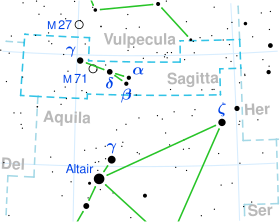
AR Aurigae, also known by its Flamsteed designation 17 Aurigae, is a binary star in the constellation Auriga. Based on parallax measurements made by the Hipparcos spacecraft, it is approximately 461 light-years from Earth.
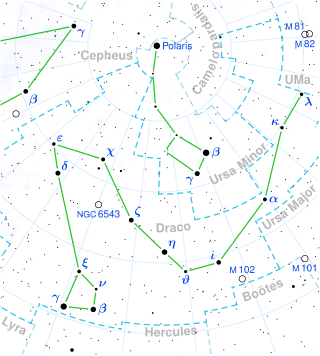
Chi Draconis is a magnitude 3.6 binary star in the constellation Draco. It also has the Flamsteed designation 44 Draconis. At a distance of 27 light years, it is one of the forty or so closest stars.
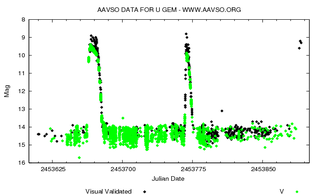
U Geminorum, in the constellation Gemini, is an archetypal example of a dwarf nova. The binary star system consists of a white dwarf closely orbiting a red dwarf. Every few months it undergoes an outburst that greatly increases its brightness. The dwarf nova class of variable stars are often referred to as U Geminorum variables after this star.

GJ 1245 is a double star with components G 208-44 and G 208-45, 14 light-years away, relatively close to the Solar System. G 208-44 is itself a closer double star made up of two red dwarfs, while G 208-45 is also a red dwarf. GJ 1245 is the 37th closest stellar system to the Solar System, located in the constellation Cygnus. GJ 1245 A and B are active flare stars, and the pair are collectively designated V1581 Cygni.

R Aquarii is a variable star in the constellation Aquarius.
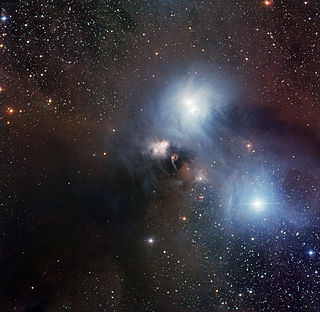
R Coronae Australis is a variable binary system in the constellation Corona Australis. It has varied between magnitudes 10 and 14.36. A small reflection/emission nebula NGC 6729 extends from the star towards SE. It is also the brightest feature of the Coronet Cluster, therefore sometimes called R CrA Cluster.

WZ Sagittae is a cataclysmic dwarf nova star system in the constellation Sagitta. It consists of a white dwarf primary being orbited by a low mass companion. The white dwarf is about 0.85 solar masses while the companion is only 0.08 solar masses. This implies that the companion is a spectral class L2 star, although this has yet to be confirmed. The distance to this system has been determined by parallax, yielding a distance of 45.1 parsecs.

SS Cygni is a variable star in the northern constellation Cygnus. It was discovered in 1896 by Louisa D. Wells, a computer working under Edward Pickering at Harvard College Observatory. It is the prototype of the subclass of dwarf novae that show only normal eruptions. It typically rises from 12th magnitude to 8th magnitude for 1–2 days every 7 or 8 weeks. The northerly declination of SS Cygni makes the star almost circumpolar from European and North American latitudes, allowing a large proportion of the world's amateur astronomers to monitor its behavior. Furthermore, since the star lies against the rich backdrop of the Milky Way band, the telescope field of view around SS Cygni contains an abundance of useful brightness comparison stars.

Gliese 208 is a red dwarf star with an apparent magnitude of 8.9. It is 37 light years away in the constellation of Orion. It is an extremely wide binary with 2MASS J0536+1117, an M4 star 2.6 arcminutes away

HD 110432 is a Be star in the south-east of Crux, behind the center of the southern hemisphere's dark Coalsack Nebula. It has a stellar classification of B1IVe, which means it is a subgiant star of class B that displays emission lines in its spectrum. This is a variable star of the Gamma Cassiopeiae type, indicating it is a shell star with a circumstellar disk of gas about the equator, and has the variable star designation BZ Crucis. It is not known to be a member of a binary system, although it is probably a member of the open cluster NGC 4609. This star is moderately luminous in the X-ray band, with a variable energy emission of 1032–33 erg s−1 in the range 0.2−12 keV. The X-ray emission may be caused by magnetic activity, or possibly by accretion onto a white dwarf companion.

Delta Sagittae is a binary star in the constellation of Sagitta, with an apparent magnitude of +3.68. The primary component is a red M-type bright giant, and the secondary is a B-type main-sequence star. It is approximately 430 light years from Earth, based on its Gaia Data Release 2 parallax.

42 Persei is a binary star system in the northern constellation of Perseus. It has the Bayer designation n Persei, while 42 Persei is the Flamsteed designation. The system is visible to the naked eye as a dim, white-hued point of light with an apparent visual magnitude of 5.11. It is located around 93 parsecs (302 ly) distant from the Sun, but is drifting closer with a radial velocity of −12.4 km/s.

AG Pegasi is a symbiotic binary star in the constellation Pegasus. It is a close binary composed of a red giant and white dwarf, estimated to be around 2.5 and 0.6 times the mass of the Sun respectively. It is classified as a symbiotic nova; it has undergone one extremely slow nova outburst and a smaller outburst.
EQ Pegasi is a nearby binary system of two red dwarfs. Both components are flare stars, with spectral types of M4Ve and M6Ve respectively, and a current separation between the components of 5.8 arcseconds. The system is at a distance of 20.4 light-years, and is 950 million years old. The primary star is orbited by one known exoplanet.
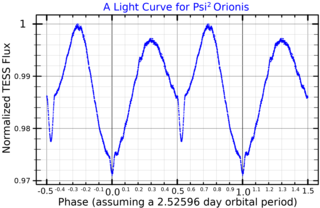
Psi2 Orionis a binary star system in the equatorial constellation of Orion. It has an apparent visual magnitude of 4.6, indicating that it is visible to the naked eye. Based upon an annual parallax shift of 2.87 mass, it is roughly 1,100 light years distant from the Sun.

BV Centauri is a cataclysmic variable binary star in the constellation Centaurus. It is a dwarf nova, and undergoes rapid increases in brightness that are recurrent with a mean period of 150 days. This period seems to have increased in the last few decades. During quiescence, its visual apparent magnitude is about 13, with variations of a few tenths of magnitude over an orbit due to differences in the star's visible surface area, brightening to a maximum magnitude of 10.7 during outbursts. From its luminosity, it is estimated that the system is about 500 parsecs (1,600 ly) away from Earth. A Gaia parallax of 2.81 mas has been measured, corresponding to about 360 pc.

V392 Persei, also known as Nova Persei 2018, is a bright nova in the constellation Perseus discovered on April 29, 2018. It was previously known as a dwarf nova.

DH Tauri, also known as DH Tau, is a type M star, located 140 parsecs away. It forms a binary system with DI Tauri 15″ away, and has a substellar companion, either a brown dwarf or massive exoplanet.

FU Tauri is a brown dwarf binary system in the constellation of Taurus about 429 light years away. The secondary is very close to the lower limit for brown dwarfs and several databases list it as a distant massive exoplanet.

V841 Ophiuchi was a bright nova discovered by John Russell Hind on 27 April 1848. It was the first object of its type discovered since 1670. At the time of its discovery, it had an apparent magnitude of 5.6, but may have reached magnitude 2 at its peak, making it easily visible to the naked eye. Near peak brightness it was described as "bright red" or "scarlet", probably due to Hα line emission. Its brightness is currently varying slowly around magnitude 13.5. The area of the sky surrounding this nova had been examined frequently by astronomers prior to the nova's discovery, because it was near the reported location of "52 Serpentis", a star John Flamsteed had included in his catalogue with erroneous coordinates.

